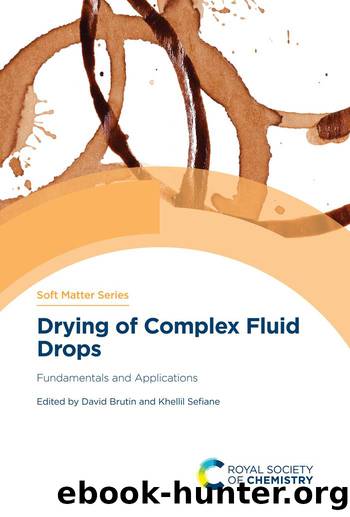Drying of Complex Fluid Drops by David Brutin;Khellil Sefiane;

Author:David Brutin;Khellil Sefiane; [Неизв.]
Language: eng
Format: epub
ISBN: 9781839161209
Publisher: Ingram Publisher Services UK
Published: 2022-05-05T21:00:00+00:00
7.4 Summary
Ink printing is one of the best established drop-on-demand additive manufacturing methods and is particularly used in the microelectronic printing process, especially for tough surfaces, in addition to other application areas such as printing on porous surfaces and biomedical-related printing. Since drop-on-demand printing is a continuous process, the generated droplet and relevant drying period on the printed surface are crucial parameters for the reliability of the method. Following these critical considerations, this chapter evaluated droplet generation, printing process, and droplet drying phenomena of the ink and microelectronic printing applications via theoretical modeling and useful applications. At first, droplet generation mechanisms were defined with the hydrodynamic and rheological parameters that were presented via the Reynolds, Weber, and Ohnesorge numbers. Thanks to these numbers, the printable droplet generation region was defined for a general-purpose use. Secondly, the critical considerations on the printing surfaces were discussed from the standpoints of droplet splashing, droplet spacing, droplet diameter in equilibrium condition, and contact line pinning. The main aim was given as continuous printing on a linear pathway without any droplet instabilities. Then, to better understand the droplet drying behavior, we focused on the single droplet and investigated the coffee-ring effect and potential dealing mechanisms such as the Marangoni flow. After theoretical modeling details, the general trends in the ink and microelectronic printing applications were summarized, and the impact of process parameters (droplet parameters, surface specifications, and ambient conditions) was discussed. In addition, specific applications of ink and microelectronic printing like metal additive manufacturing, printing on a porous surface, or biomedical purposes were mentioned. Lastly, the system-scale drying processes of ink and microelectronic printing were presented with their pros and cons.
Download
This site does not store any files on its server. We only index and link to content provided by other sites. Please contact the content providers to delete copyright contents if any and email us, we'll remove relevant links or contents immediately.
The Complete Stick Figure Physics Tutorials by Allen Sarah(7189)
Secrets of Antigravity Propulsion: Tesla, UFOs, and Classified Aerospace Technology by Ph.D. Paul A. Laviolette(5129)
Thing Explainer by Randall Munroe(3821)
The River of Consciousness by Oliver Sacks(3455)
The Order of Time by Carlo Rovelli(3082)
How To by Randall Munroe(2941)
I Live in the Future & Here's How It Works by Nick Bilton(2867)
A Brief History of Time by Stephen Hawking(2854)
The Great Unknown by Marcus du Sautoy(2567)
What If?: Serious Scientific Answers to Absurd Hypothetical Questions by Randall Munroe(2562)
Midnight in Chernobyl by Adam Higginbotham(2407)
Blockchain: Ultimate Step By Step Guide To Understanding Blockchain Technology, Bitcoin Creation, and the future of Money (Novice to Expert) by Keizer Söze(2393)
Networks: An Introduction by Newman Mark(2285)
The Meaning of it All by Richard Feynman(2240)
Easy Electronics by Charles Platt(2232)
The Tao of Physics by Fritjof Capra(2185)
Midnight in Chernobyl: The Untold Story of the World's Greatest Nuclear Disaster by Adam Higginbotham(2100)
When by Daniel H Pink(2041)
Introducing Relativity by Bruce Bassett(2033)
